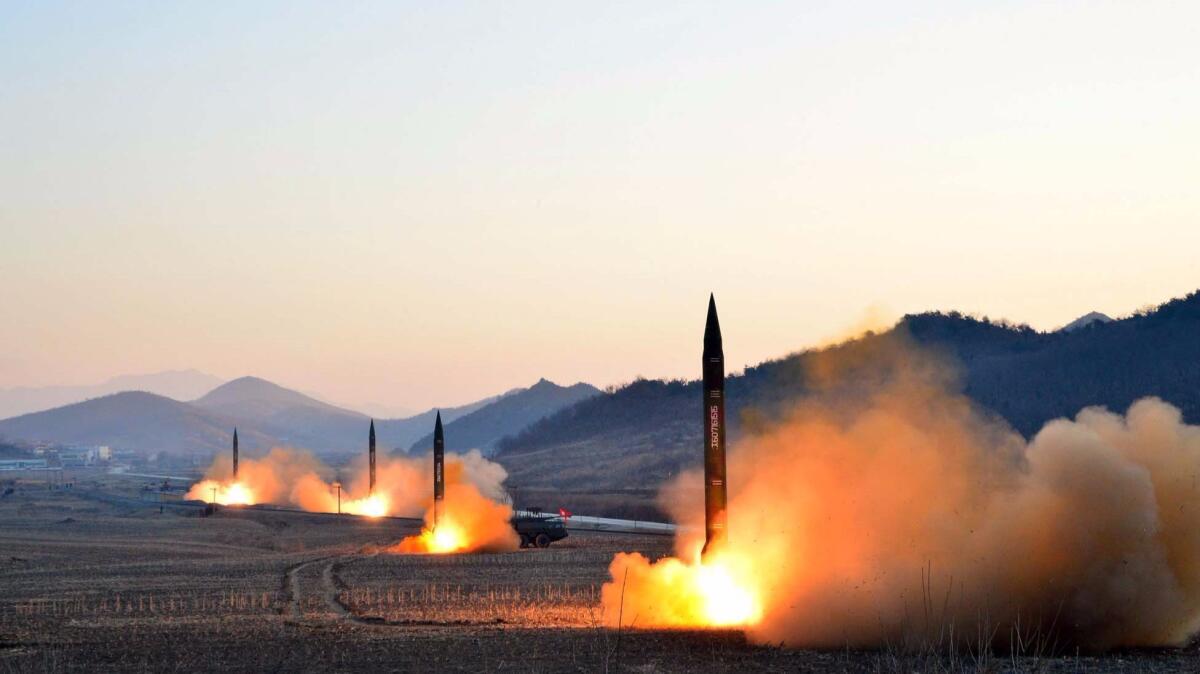Japan considers more muscular military role to counter North Korea

- Share via
Reporting from TOKYO — After seven decades of relying chiefly on U.S. military guarantees, Japan is considering moving its Self-Defense Forces into a more aggressive posture to help counter the growing threat from North Korea and China’s expanding military in the region.
U.S. Secretary of State Rex Tillerson makes his first official visit to Tokyo, Seoul and Beijing this week, and his talks are expected to focus in large part on regional worries about North Korea, which test-launched four ballistic missiles last week.
His visit comes as U.S., South Korean and Japanese warships conduct military exercises off North Korea to test their ability to shoot down ballistic missiles, the U.S. Navy said. The government in Pyongyang has denounced the exercises, which have added to rising tensions in the region.
At the same time, China has sharply criticized Washington for rushing an antimissile system known as Terminal High-Altitude Area Defense, or THAAD, to South Korea. Chinese analysts say the sophisticated radar also could be used to track Chinese missiles, giving the U.S. an advantage in case of war.
Now Japan reportedly plans to deploy its largest warship, the Izumo helicopter carrier, on a three-month tour through the South China Sea in what would be the largest show of Japanese naval force in the region since World War II.
The government in Tokyo also is considering obtaining land- or ship-based Tomahawk cruise missiles, or jets armed with standoff missiles or precision-guided bombs, for the first time.
Doing so would mark a milestone for a nation that has sent its troops abroad only for international peacekeeping missions since 1945.
“After 70 years without war, it is difficult to convince Japanese that the time of peace could be over,” said Toshimichi Nagaiwa, a retired lieutenant general and F-15 fighter pilot.
“Look around us, our neighbors are increasing their capabilities,” he said. “If Japan wants to send a message of deterrence, it needs to have the right weapons.”
Under the 1947 Constitution, Japan renounced war as a way to settle international disputes and affirmed that it will never again maintain “land, sea, or air forces or other war potential.”
During the Korean War, Japan was allowed to create a “self-defense” force to protect itself, but not to wage offensive war. The air, naval and ground forces now comprise about 250,000 personnel and cost $41 billion last year.
The United States has pledged to defend Japan under its “nuclear umbrella” and still stations about 54,000 American troops in Japan, more than in any other country.
But the growing threat from North Korea, which has tested increasingly sophisticated missiles and larger-yield nuclear devices, has sparked a debate on whether Japan should play a more aggressive role in defending itself.
The Japanese government has determined that it has the right to act preemptively to prevent an imminent attack. And the parliament agreed in 2015 to allow Japanese troops to come to the aid of allies overseas under a doctrine of collective defense.
But Japan has not obtained weapons that would allow for a first strike.
“Legally, there is no issue,” said Yoshihide Soeya, a political science professor at Keio University’s law school in Tokyo. “The issue is the allergy to military action within Japan.”
Japan already has sea- and land-based missile defense systems that are supposed to stop an incoming North Korean barrage. The government is considering adding THAAD units, but experts say they could be overwhelmed in a large-scale attack.
“If there are three or four missiles coming at you, it will make your life difficult to stop them,” said Narushige Michishita, a former Japanese Defense Ministry official who teaches at the National Graduate Institute for Policy Studies in Tokyo. “Nothing is 100% efficient.”
The Japanese government called North Korea’s test of four ballistic missiles this month a simulated “saturation attack” designed to overwhelm Japan’s defense systems by launching a volley of missiles at a single target. The four fell in the ocean about 200 miles off Japan.
Prime Minister Shinzo Abe’s ruling Liberal Democratic Party has convened a defense study group to examine military policies, including potential first strike capabilities.
“Japan needs to come to its own defense,” said Hideaki Kaneda, a retired Japanese vice admiral and fellow at the Japan Institute of International Affairs. “Japan needs to become a normal country.”
Abe was one of the first foreign leaders to visit President Trump after the inauguration, and they were at Trump’s Mar-a-Lago resort in South Florida when North Korea test-launched a ballistic missile on Feb. 12. Photos posted on Facebook by another guest showed the two leaders conferring over dinner when the news was announced.
Twitter: @wjhenn
ALSO:
Climate change is real: Just ask the Pentagon
Overweight, tattooed, stoned? The Pentagon may still want you
More to Read
Sign up for Essential California
The most important California stories and recommendations in your inbox every morning.
You may occasionally receive promotional content from the Los Angeles Times.











